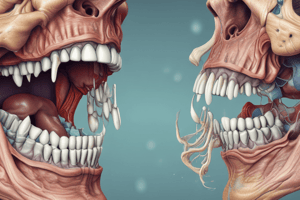Podcast
Questions and Answers
Which imaging technique is NOT recommended for accurately diagnosing sinusitis?
Which imaging technique is NOT recommended for accurately diagnosing sinusitis?
- X-ray
- MRI (correct)
- Panoramic radiography
- CT scan
Which imaging technique plays an important role in diagnosing sinusitis?
Which imaging technique plays an important role in diagnosing sinusitis?
- X-ray (correct)
- MRI
- Ultrasound
- PET scan
What are some common causes of acute sinusitis?
What are some common causes of acute sinusitis?
- Nasal allergy
- Foreign matter
- All of the above (correct)
- Bone grafts
What are the causes of acute and chronic sinusitis?
What are the causes of acute and chronic sinusitis?
What are some symptoms of acute sinusitis?
What are some symptoms of acute sinusitis?
What are the symptoms of acute sinusitis?
What are the symptoms of acute sinusitis?
What medication is commonly prescribed for acute sinusitis?
What medication is commonly prescribed for acute sinusitis?
What medication is prescribed for acute sinusitis before surgical treatment?
What medication is prescribed for acute sinusitis before surgical treatment?
Which antibiotics are prescribed for two weeks to treat acute sinusitis?
Which antibiotics are prescribed for two weeks to treat acute sinusitis?
Which antibiotic is commonly prescribed for treating acute sinusitis?
Which antibiotic is commonly prescribed for treating acute sinusitis?
What imaging technique is necessary to accurately assess chronic sinusitis?
What imaging technique is necessary to accurately assess chronic sinusitis?
What is a common cause of chronic sinusitis?
What is a common cause of chronic sinusitis?
What can chronic sinusitis be caused by?
What can chronic sinusitis be caused by?
What is NOT recommended for treating chronic sinusitis?
What is NOT recommended for treating chronic sinusitis?
What imaging technique is necessary for accurate diagnosis and surgical planning for successful implant surgery?
What imaging technique is necessary for accurate diagnosis and surgical planning for successful implant surgery?
What is not recommended for chronic sinusitis?
What is not recommended for chronic sinusitis?
Can implants be placed without bone graft for chronic sinusitis?
Can implants be placed without bone graft for chronic sinusitis?
What imaging technique is necessary for accurate diagnosis and surgical planning for successful implant surgery?
What imaging technique is necessary for accurate diagnosis and surgical planning for successful implant surgery?
What is the purpose of CT scans in monitoring sinusitis?
What is the purpose of CT scans in monitoring sinusitis?
What is the main focus of Dr. Kim Jong-un's discussion?
What is the main focus of Dr. Kim Jong-un's discussion?
Flashcards are hidden until you start studying
Study Notes
- Dr. Kim Jong-un is discussing pathology and diagnosis of maxillary sinus lesions.
- X-ray plays an important role in diagnosing sinusitis, along with panoramic radiography and CT.
- Acute and chronic sinusitis are caused by nasal allergy, foreign matter, bone grafts, or septal deviation.
- Symptoms of acute sinusitis include fever, headache, facial fullness, pain in the upper posterior area, toothache, nasal obstruction, and post-like nasal discharge.
- Medication, including antibiotics and pseudoephedrine, is prescribed for acute sinusitis before surgical treatment.
- Case studies are presented to demonstrate the diagnosis and treatment of acute sinusitis.
- Antibiotics, such as augmentin, are prescribed for two weeks to treat acute sinusitis.
- CT scans are used to monitor the progression of sinusitis and the effectiveness of treatment.
- Panoramic radiography is used to provide a big picture for implant treatment, while CT scans are used for more accurate information.
- Dr. Kim Jong-un emphasizes the importance of using x-ray, panoramic radiography, and CT scans for accurate diagnosis and treatment of maxillary sinus lesions.
- Patient had oral anterior fistula and maxillary osteo was maintained with medication but symptoms worsened
- Endoscopic sinus surgery was planned and performed to restore maxillary sinus function
- Panoramic image is insufficient in diagnosing sinusitis, CT scan is necessary to accurately assess the condition of the sinuses
- Antibiotics such as augmentin, cephalosporin, adisromycin or clindamycin are prescribed for acute sinusitis
- Chronic sinusitis can result in pain, headache, and posterior nasal drip for several months to years
- Bone graft is not recommended for chronic sinusitis as it can result in infection
- Chronic sinusitis can be caused by chemical damage, maxillary ostium blockage, inflammation associated with teeth, root apex inflammation, and abscess, as well as continued periodontal disease
- CT scan is necessary to accurately assess chronic sinusitis and prescribe appropriate antibiotics
- Implants can be placed without bone graft for chronic sinusitis, but shorter implants may be necessary
- Cone beam CT is necessary for accurate diagnosis and surgical planning for successful implant surgery.
Studying That Suits You
Use AI to generate personalized quizzes and flashcards to suit your learning preferences.




